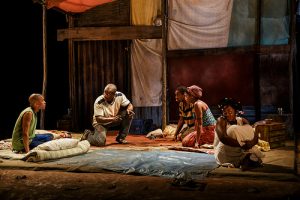Never Mind the Tiger, If This Is Haiti, Who Are These Kids?
There’s passion and touching anguish in the new play at the La Jolla Playhouse but there isn’t much coherence.
Five persons – two female and three male – live together in a crude hovel pulsing with a poison beyond mere destitution. Jeff Augustin’s The Last Tiger in Haiti is their story.
Except it isn’t, really. There’s too much context to discover behind the writerly tricks for a narrative to emerge. Random references assume an improbable knowledge of the setting but who are these people? The actors are adults but their exchanges are childlike. There are frequent sexual overtones but they all sleep within reach of each other and there seems to be no particular overt activity. There is every evidence that they are slaves but nothing to set the time-period. The only solid clue is the title: This must be poor, exhausted Haiti.

La Jolla Playhouse The Last Tiger in Haiti features, left to right, Clinton Roane, Andy Lucien, Reggie D. White, Jasmine St. Clair and Brittany Bellizeare. Jim Carmody Photo
The story struggles and stumbles beneath the burden of an opaque dialect. (Such details give flavor to an exotic setting but, with the point made, they are best eased in the interests of comprehension.) Reading the child/adult body language while straining to extract meaning from garbled speech just finally makes keeping up tedious.
A couple of program notes help a lot. Excess children of desperately poor Haitian families are given to slightly more prosperous households where they are used as slaves. These restaveks apparently are illegal but widespread. It’s a horrific practice and it deserves exposure. But Augustin has wandered away into Romanticism and melodrama.
The second act of Tiger is set, years later, in what looks like a business suite of a mid-level Miami hotel where one survivor of the five restaveks has invited another one to share some of the prosperity generated by a tell-all childhood memoir. Except the visitor isn’t buying it and demands that “the truth” be told. That truth, festooned with all kinds of detail not mentioned in Act I, makes a big difference in the whole story, by golly. As in George Orwell’s “Animal Farm,” all the animals were equal but some were more equal.
I, for one, would have preferred less bombshell surprise and more solid examination of an appalling reality new to me. Another round of authors-making-up-facts is far less interesting than slaves surviving cruel anarchy near here and nowadays.
Joshua Kahan Brody’s staging is confident, muscular and brisk, an acceptable approach given the communication challenges. Probably, he could have traded some atmosphere for clarity. Example: Two characters in scary costumes burst into a room threatening one of the girls. Apparently, it’s carnival time or something, but this strand of the story soon fades, leaving only the intimidating costumes and makeup and a distant sound of ominous music which might be something to do with the carnival or may be just disturbing soundtrack. All colorful but hardly instructive.
Of the five, Reggie D. White is perhaps the most effective, a restless skeptic choking on bitterness. Clinton Roane wears two stereotypes – “follower” and “loser” – with sad grace and Jasmine St. Clair is appealing without finding much continuity in her duties as the “other girl.”
Brittany Bellizeare and Andy Lucien are the most disorienting as children, and suggest why when they return as grownups in Act II. She plays the little girl as a masquerade and the adult as a sleek manipulator who has discovered all important keys to survival. But Lucien – on a solemn, dignified mission – always resembles, even as a grownup, a kindly but dour uncle, old beyond his years.
There are twists and curls to this story that would be better off in a play of their own, like one of the instructive folktales included here, where a would-be storyteller announces “Kric?” and willing listeners gather around with an anticipatory “Krac.” Charming custom. But I need a clearer understanding of its origins and of where, when and how it survives, please.
(Continues at 7:30 p.m. Tuesdays and Wednesdays; at 8 p.m,. Thursdays-Saturdays; at 2 p.m. Saturdays and Sundays; and at 7 p.m. Sundays through July 24, 2016, in the Mandell Weiss Forum.

Welton Jones has been following entertainment and the arts around for years, writing about them. Thirty-five of those years were spent at the UNION-TRIBUNE, the last decade was with SANDIEGO.COM.



Wow…so sorry you had to sit through that garbled dark people speech that so many people in this world consider a language. Way to demean the Haitian creole dialect and demand the playwright walk you through a history that’s existed for decades and rather than present these kids as pathetic, sought to present them as human beings rather than the kids you don’t help or care about for 10 cents a day. I wonder had you been watching the work of McDonagh would you still have been so burdened having to listen to something that your ears aren’t accustomed to. Privilege is a beautiful thing isn’t it?